A potpourri of sorts on this Saturday morning. Each of the following photos was taken in the last couple of weeks and all but one were taken in the Wasatch Mountains.
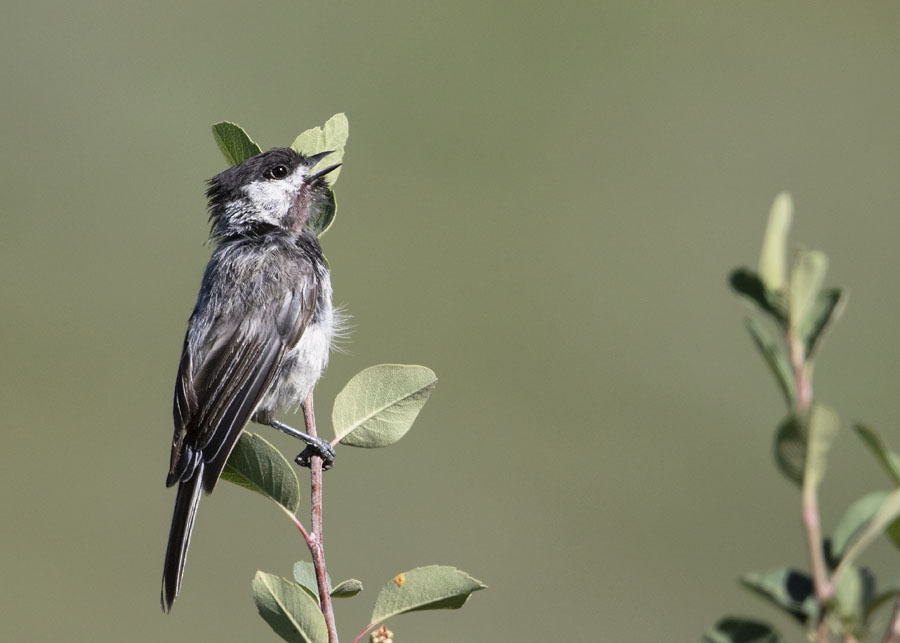
1/3200, f/6.3, ISO 800, Canon 7D Mark II, Canon EF 500mm f/4L IS II USM + EF 1.4 III Extender, not baited, set up or called in
I’ll start with this extremely scruffy-looking Black-capped Chickadee who looks like it was rode hard and put away wet. I imagine its poor condition is a result of both molting and the strains and stresses of raising a family. I’m surprised it even felt like singing. Like humans, birds have their less than stellar moments and I like to document my avian subjects whether they’re looking their best at the time or not.
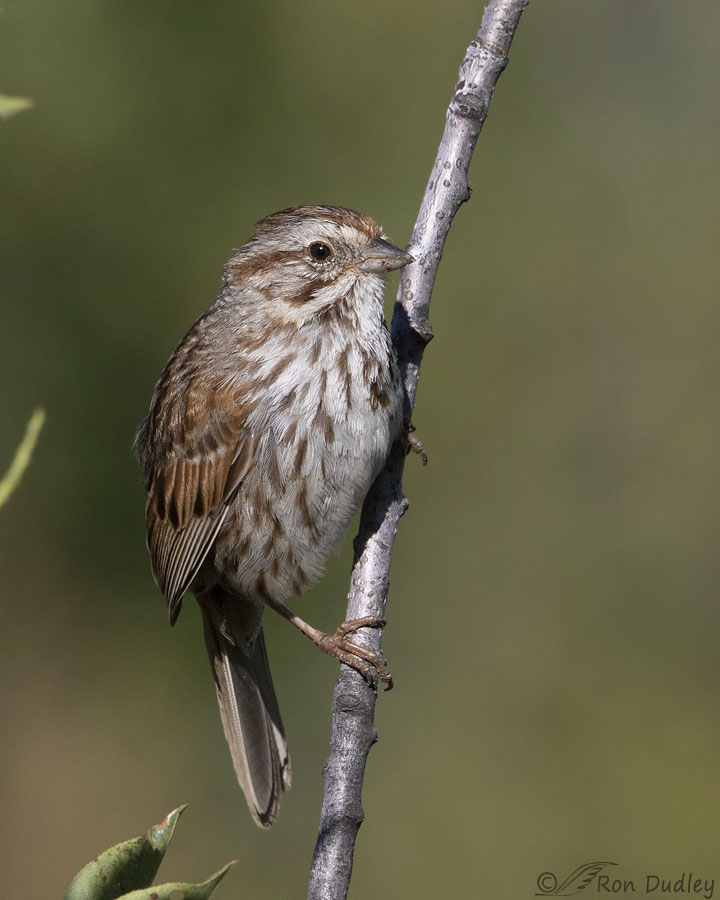
1/640, f/16, ISO 800, Canon 7D Mark II, Canon EF 500mm f/4L IS II USM + EF 1.4 III Extender, not baited, set up or called in
A Song Sparrow on a vertical perch. My camera settings for this photo were a mistake. I forgot to change them after photographing a different subject that needed more depth of field.
1/1000, f/11, ISO 800, Canon 7D Mark II, Canon EF 500mm f/4L IS II USM + EF 1.4 III Extender, not baited, set up or called in
Two Uinta Ground Squirrels perched high and dry on top of sagebrush. Normally this shot wouldn’t work very well for me because of all of the twigs in front of the squirrel on the left but in the end I liked the peekaboo effect of its eye looking at me through the opening in the twigs.
While I had these rodents in my viewfinder I was fooled by what I was seeing. For some reason I was convinced that the squirrel on the left was quite a distance behind the other squirrel so even though I went to f/11 for this shot I thought one of the squirrels would be soft in all of my photos. So I didn’t take very many shots of them. I was wrong about the sharpness so both squirrels must have been about the same distance from me.
Depth/distance can be deceiving.
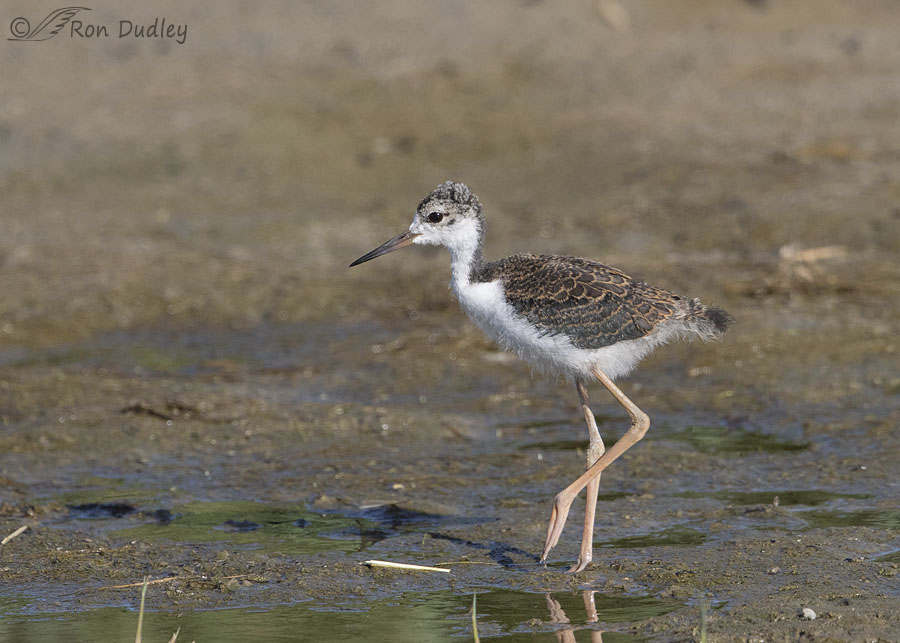
1/2000, f/6.3, ISO 500, Canon 7D Mark II, Canon EF 500mm f/4L IS II USM + EF 1.4 III Extender, not baited, set up or called in
Yesterday I posted a juvenile Black-necked Stilt but obviously this chick at Bear River MBR is much younger than that bird. One of the parents of this youngster was highly excitable whenever the chick would wander too close to potential threats while it was foraging for food. Man, do stilts ever make a lot of noise in that situation!
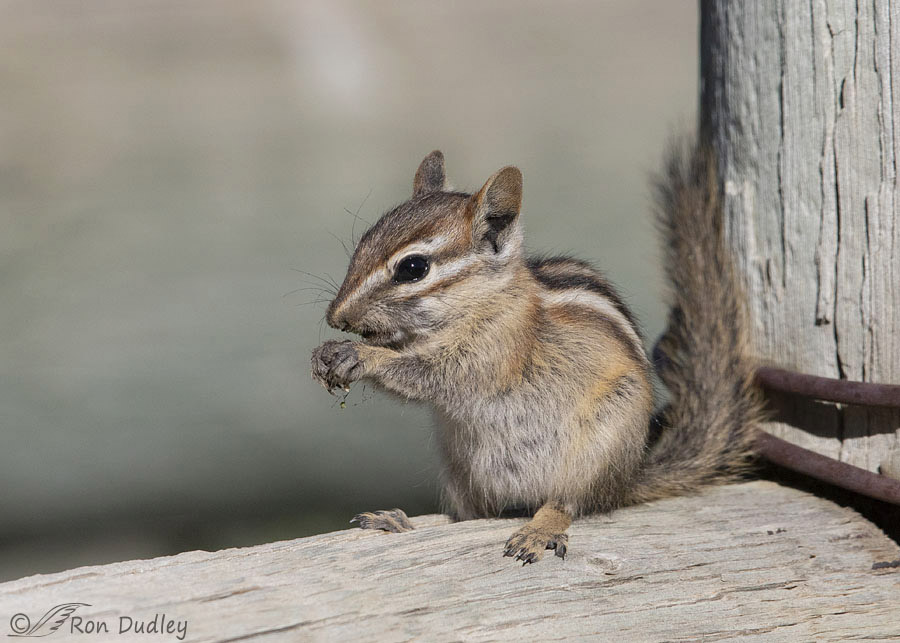
1/3200, f/9, ISO 800, Canon 7D Mark II, Canon EF 500mm f/4L IS II USM + EF 1.4 III Extender, not baited, set up or called in
“Chippies” always make me smile but this one cracked me up. Look at the photo of this Least Chipmunk carefully. Do you see anything… peculiar?
Where in the world did those toes wrapping around the edge of the horizontal fence rail come from? At first glance it looked to me like there must be another chipmunk below the rail and out of sight that was about to climb over the edge of the rail and pull itself up with that foot. But of course I knew almost immediately that I needed to look for another explanation.
Next my mind’s eye told me that the chipmunk’s right leg must be hanging over the far side of the rail and the part of the right foot that we can see was wrapping over the edge toward the viewer. But closer inspection told me that doesn’t work either because the claws on the foot are pointing the wrong way. So I was back to square one.
Finally I figured it out. The chipmunk’s right leg is buried in a deep groove on the rail and all we can see is some of its toes coming out of the groove, pointing away from us and hanging over the far edge.
Sheesh, I can be a little dense sometimes.
Ron


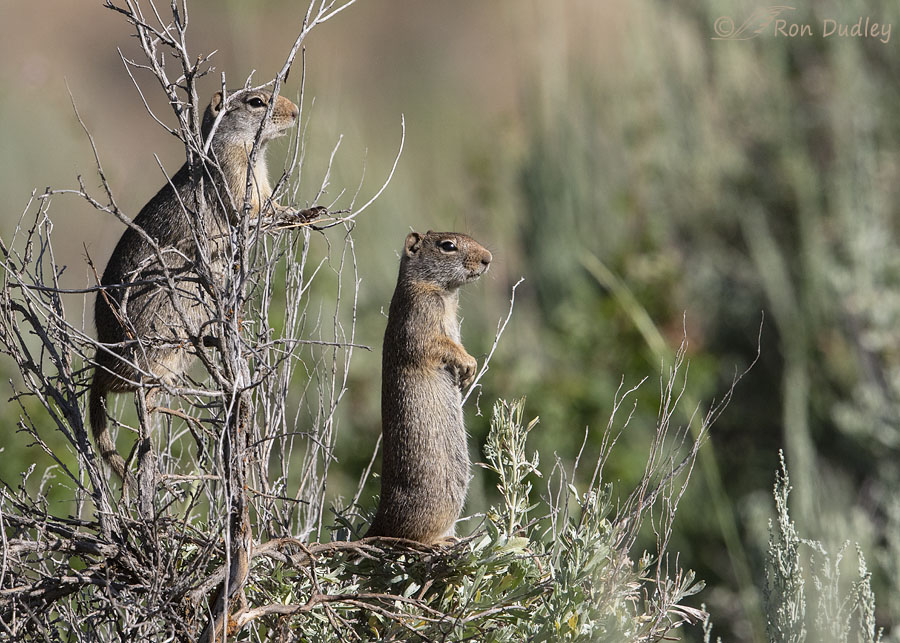
That crack in the wood does not make for a quick get away. Must be hungry for the nibblies. Enjoy the captures this time of year with the juveniles.
I really like this series because I shot everything alive and I like a verience to look at. You are such a fabulous photographer. So al your work is delightful! I did enjoy the “foot” mystery tho.
Linda
I loved this series…am trying to save a chimney Swift now…nest caught fire from a carelessly flipped cigarette…all others died…horrible!!! They are terribly hard to feed and rehab…will probably lose this baby, too…more and more often, I find myself hating people, just liking other animsls….
I wish you the best of luck with the baby swift, Patty. Given the situation as I imagine it I’ve gotta wonder how careflessly that smoke was flipped…
Neither baby swift made it…first one made it for only a day, second died a few hours ago…had hoped it might survive…they are very, very difficult to raise because they don’t open up their mouths like other baby birds and want to be fed from below…food has to be pretty specific , too…ex. Wax worms….I feel mad and sad…people are often garbage in my book….sorry! But sometimes I hate them!!! More and more often…..
Lovely grouping. I agree the chickadee looks to be a juvenile molting into adult plumage. However sometimes when adults go through a hard molt you cans see the gray fluffy part of the feathers that are close to the body. I was looking for pdf online from the book, Manual of Ornithology Avian Structure and Function, about feather form and function. The book has wonderful diagrams and explanation of feather types like plumulaceous and semiplumes. This explanation from Cornell Lab Bird Academy is a good description and illustration. https://academy.allaboutbirds.org/feathers-article/2/
I am out of school now and have no apts. for the next week, I hope the weather is good so I can get out more, if not to photograph at least to enjoy the scenery.
I wish you luck getting out, April. It’s going to be hot so I hope you can get out early in the day at least part of the time.
A truly delightful potpourri. I hope its scent carries through the rest of the day.
And no, the foot position mystified me until I had your explanation. And I can still only think that it is one deep groove. A very deep groove.
Quite the menagerie. All interesting and fun to see. I agree with the description of the Chickadee. I see them every day and they are always impeccably groomed.
I don’t remember ever seeing a chickadee in rougher shape than this one, Lyle.
Ron, thanks for your interesting collection of photos and your always interesting narrative. My favorite is the ‘chippie’ and the foot mystery. I along with you did not figure it out until I was told what was going on. Love the way the stripe starts at the face and runs down the back…pretty coloring. Great post, Ron
Thanks, Alice. I love little photo-mysteries like that, as long as I can figure them out in the end.
Lovely group! Looking at all these critters in the wild – just the ticket when you’re sitting inside at blah work.
Thanks, Joanne. I’m about to go outside and repair sprinkler heads in the heat. I do believe I’d rather be inside at blah work…
Deeeeee-lightful critterpourri! So much fun, Ron. These are my favorite types of posts. Almost thought you might sneak in a moon (orbiting rock, not bare tushie) shot in honor of the day.
So much fun, Ron. These are my favorite types of posts. Almost thought you might sneak in a moon (orbiting rock, not bare tushie) shot in honor of the day.
Perspective can be a strange thing — the peek-a-boo Uinta Ground Squirrel looks to be closer to you than its friend. I definitely needed to embiggen the chippie shot to figure out what was going on with its foot. Too stinkin’ cute! And that poor, bedraggled Chickadee. I’m picturing more of an exasperated utterance than a song.
Marty, I should change my ways and aim my 1120mm focal length at the moon one day. I never have, at least not seriously.
Part of the problem is that at least in the warmer months I’m always in bed before or very soon after it gets truly dark and on mornings that have clear skies I’m usually off on a birding expedition very early.
And not to worry, the world has seen the last of my bare tush!
Many thanks for showing some young birds, they are great shots. This time of year is tough for adults since they have gone for a long time with the same feathers, but some will shortly molt.
Thanks for sharing!
Thank you, Dick.
All really good photos. That very young Stilt is adorable as are the other youngsters. Both squirrels are sharp and a nice picture. Never heard of Uinta Squirrels – at first I thought they were named after Johnny Unitas until I reread that Had no problem with the Least Chipmunk’s foot, and did notice it immediately. Have never seen a Black-capped Chickadee – pretty bird even in its stressed condition. Thanks for these Ron, and where were you 50 years ago today when the moon landing was taking place? Were you a nature photographer back then?
Had no problem with the Least Chipmunk’s foot, and did notice it immediately. Have never seen a Black-capped Chickadee – pretty bird even in its stressed condition. Thanks for these Ron, and where were you 50 years ago today when the moon landing was taking place? Were you a nature photographer back then?
Thanks, Everett.
To be perfectly honest I don’t remember where I was. I was so intensely interested in all those Apollo missions I watched them all from beginning to end whether they were in the middle of the night or not. So today all these years later they kind of run together in my mind. To me each one was momentous.
But nope, I wasn’t a nature photographer back then. I was doing my student teaching at South High School in Salt Lake City where I landed a teaching job the following year. Didn’t even know how to operate a camera…
Love the medley this morning! At first glance and perhaps second, the chipmunk did not jump out at me as ‘chipmunk’…far cry from the normal round little bird with smooth feathers. You caught him in his alter-ego. I know you prefer horizontal presentations most of the time, but I find the vertical ones you have shown to be very appealing to me like the sparrow. Nice to see the age progression with the juvie stilts…I like the color of the head feathers on this younger one and it’s ‘fuzziness’. Your non-avian friends are too cute. At first I thought another chippie was trying to crawl up but then seeing the direction of the nails I knew this fella had his legs splayed out weirdly. My favorite photo is the Unitas…’I see you, do you see me?’ Love everything about it…both of them giving you ‘the look’ but the sagebrush, twigs, the legs resting on the bush and the 3-D effect of all that popping away from the background. Yes…that’s my favorite. Many thanks for sharing this potpourri this a.m.
Many thanks for sharing this potpourri this a.m.
Kathy, I like vertical presentations too, when they’re appropriate for the subject. The main reason I have a problem with verticals is that I post links to my posts on Facebook and FB nearly always butchers vertical compositions in their preview image.
I’m glad you enjoyed the potpourri. Some readers would rather I focus on a single species each post but I like the occasional change.
Wonderful variety to start the day – 39 this morning and to be 96 by Tues! GEEZ! The chickadee certainly IS a mess!
– 39 this morning and to be 96 by Tues! GEEZ! The chickadee certainly IS a mess!  Wasn’t even sure what it was until you told us. Uinta Ground squirrel were a real puzzle – knew they weren’t gophers (I know also a ground squirrel) We have a prairie dog town just W of us and knew they weren’t that either. For whatever reason the Chipmunk foot wasn’t a puzzle and the Stilt really is a jumble of parts at that stage….:) Appears the sparrow had already had breakfast.
Wasn’t even sure what it was until you told us. Uinta Ground squirrel were a real puzzle – knew they weren’t gophers (I know also a ground squirrel) We have a prairie dog town just W of us and knew they weren’t that either. For whatever reason the Chipmunk foot wasn’t a puzzle and the Stilt really is a jumble of parts at that stage….:) Appears the sparrow had already had breakfast.
Judy, it’s refreshingly cool here this morning too. 60° about a half hour ago which is almost 20° cooler than it was at the same time a couple of mornings ago.
Are the prairie dogs you refer to actually the Richardson’s Ground squirrels that are so prolific around Cut Bank? Or not…
Big fat prairie dogs is all I know……. Town fluctuates in size from year to year. MANY years ago Joe’s dad/others/govt. set out to wipe out the “dogs” in the area – got ’em all BUT this one….. Still those who want to go shooting up there which we don’t allow tho many years ago we did. Love to watch eagles/hawks cruising the flat as well as coyotes working it. Sometimes they get lucky…..
Town fluctuates in size from year to year. MANY years ago Joe’s dad/others/govt. set out to wipe out the “dogs” in the area – got ’em all BUT this one….. Still those who want to go shooting up there which we don’t allow tho many years ago we did. Love to watch eagles/hawks cruising the flat as well as coyotes working it. Sometimes they get lucky…..
Black Tail Prairie Dog as close as I can tell – WAY bigger than “gophers”……..
Ok, thanks for the response, Judy. All we saw in Glacier County was the “gophers”.
I really enjoyed this series along with my morning coffee! It’s a great display of how unique each creature is and how unique each situation is. Thank yhou for sharing your art, Ron! (And for explaining the chipmunk leg. Not sure I could’ve worked that out.)
“It’s a great display of how unique each creature is and how unique each situation is.”
Well said, Wally.
I’m relieved! I was afraid that chipmunk foot would be obvious to everyone but me.
Thanks for explaining that foot position. I couldn’t figure it out.
The song sparrow may be a young of the year. The wide malar streaks are not solid colored. The tail feathers may not be grown out, either.
There is down sticking out of the chickadee’s breast and the throat is not as black as the cap. The browninsh color may be due to the lighting. I have not gotten a good enough look at the recently fledged chickadees around my house to tell if their throats are brown compared to their caps. Do adults show down when molting?
“Thanks for explaining that foot position. I couldn’t figure it out.”
Pam, it’s nice to know that I’m not the only one who couldn’t initially figure it out.
I’d be surprised if adult Song Sparrows show down when molting.
It’s the chickadee fledgling that’s showing down in your photos.
Oops, you made that clear. I just didn’t read carefully enough.